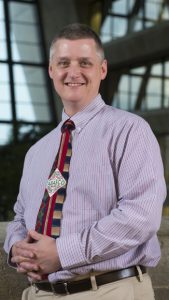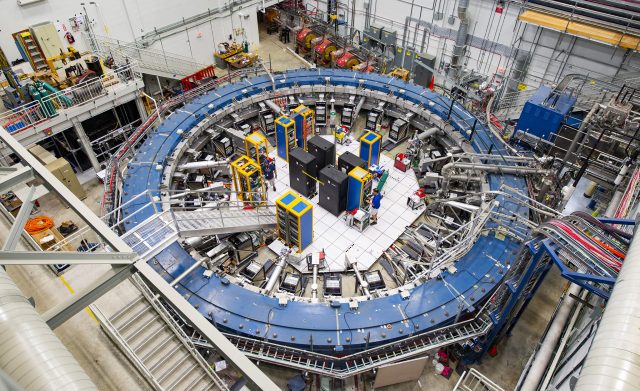
The core component of the Muon g-2 experiment at the Fermi National Accelerator Laboratory is a 50-foot superconducting electromagnet. When muons orbit around the storage ring at nearly the speed of light, they interact with the magnetic field and the quantum fields of the vacuum. Scientists are using the experiment to search for hidden particles and forces. Photo courtesy Fermilab
OXFORD, Miss. – University of Mississippi researchers are playing a key role in a groundbreaking search for undiscovered forms of matter and energy that could unlock an exciting new era of physics.
On April 7, researchers working at the Fermi National Accelerator Laboratory in Illinois announced that their exploration of a tiny subatomic particle called a muon showed the fundamental particle behaving in a way not predicted by the Standard Model of particle physics. A potential explanation for this discrepancy between the theory and experiment is the existence of undiscovered particles or forces.
Breese Quinn, a professor of physics and astronomy at UM, leads a group of physicists involved in this effort, which produced the first results from the Muon g-2 experiment, in which beams of muons are propelled through a ring of intense magnetic fields to study the particle’s rotation or wobble.
“This has been the single most anticipated result in all of particle physics over the last several years, because for two decades we have waited to find out if the g-2 discrepancy will break the Standard Model and lead to a real discovery of new physics,” said Quinn of the theory developed in the 1970s that describes how the universe’s basic building blocks and fundamental forces are related to each other.
“The result confirms that discrepancy and gives us much more confidence that we have truly found something new.”
The new data, combined with results from an experiment at Brookhaven National Laboratory in New York that concluded in 2001, is corroboration that the best theoretical model of the subatomic world is incomplete.
“The Standard Model of particle physics has been one of the most successful theories in the history of science,” Quinn said. “It has correctly predicted and described a tremendous variety of phenomena for 50 years.
“Although it doesn’t cover all physics, up to now, essentially everything it does contain has been described successfully – the Standard Model has yet to be ‘broken.’ This result represents the strongest evidence we have to date of a significant discrepancy between particle physics theory and experiment, of a real crack in the Standard Model.”
An International Team
Quinn is a principal investigator involved in the Muon g-2 experiment at Fermilab that includes more than 200 scientists in an international collaboration among dozens of labs and universities in seven countries.
The collaboration includes a group of current and former UM researchers who are playing a leading role in the beam dynamics of the Muon g-2 experiment. The UM group is largely responsible for storing, controlling and understanding the beams of muons, which are heavy siblings of the electron that exist for only about 2.2 millionths of a second and act as a window into the subatomic world.
“Our current and former team members led the work to construct, commission and operate the experiment’s storage ring,” Quinn said. “We continue to lead analysis efforts to understand the details of how the muons are stored and move around within our ring.
“These studies are critical to increasing the precision with which we can measure the g-factor, an important quantity related to the magnetic moment of the muon.
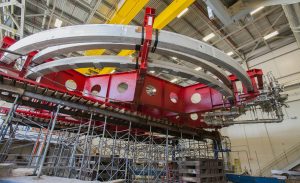
The Muon g-2 experiment ring sits in its detector hall at the Fermi National Accelerator Laboratory. Photo courtesy Fermilab
“I also lead the Muon g-2 analysis group trying to identify exactly what new particles or forces could be responsible for this g-2 discrepancy. Our UM graduate students are searching the data for signs of new forces that could be violating the basic symmetry rules of relativity and quantum physics as we know them, and for evidence of dark matter interacting with the muons.”
Other Ole Miss researchers involved in the Muon g-2 group include Jason Crnkovic, a postdoctoral research associate working at Fermilab; Meghna Bhattacharya, a Ph.D. candidate in physics; Jenny Holzbauer and Alex Keshavarzi, former UM postdoctoral research associates; and Wanwei Wu, a former UM graduate student.
Bhattacharya will present a colloquium on the first results from the Muon g-2 experiment on April 22. The academic seminar is available via Zoom through the Department of Physics and Astronomy.
“My involvement over these years ranges from participating in hardware upgrades needed for the experiment to physics analysis and studying very subtle effects using the g-2 data,” said Bhattacharya, who has been based at Fermilab since January 2018 and will graduate from UM in May with her doctorate in experimental high-energy physics.
“Besides this, I very much enjoy participating in outreach activities – being able to pass on the passion to the younger generation and share my personal experiences. To let them know that there is nothing in the world to stop them from getting their hands dirty with hardware to writing codes is what I thoroughly enjoy.”
Inside the Experiment
Muons occur naturally when cosmic rays strike the Earth’s atmosphere, and Fermilab’s particle accelerators also can produce them in large numbers.
The particles act as though they have a tiny internal magnet, and when accelerated through the lab’s 50-foot ring of magnetic fields, the direction of the muon’s magnet precesses, or wobbles, much like the axis of a spinning top on a table. The rate of this wobble can be calculated with ultra-high precision.
As the muons circulate in the Muon g-2 magnet, the Standard Model predicts this rate, but the data released April 7 hints at additional forces or particles not accounted for by the Standard Model tweaking this rate.
“We know that the Standard Model is an incomplete theory,” Quinn said. “Among other things, the Standard Model does not include dark matter, does not explain the accelerating expansion of the universe, and does not fully account for the asymmetry between matter and antimatter.
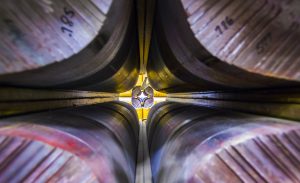
A group of Muon g-2 experiment particle storage rings at the Fermi National Accelerator Laboratory. Photo courtesy Fermilab
“Therefore, we know there is new physics lying beyond the Standard Model that we do not understand causing real effects in our universe. That physics may be nothing new under the sun, but it will be new to us, and it is our job to go find it and learn how it works.”
The Muon g-2 experiment, which started at Fermilab in 2018, analyzed the motion of more than 8 billion muons from that first run. The new measurement from the experiment strongly agreed with data from the Brookhaven National Laboratory.
Researchers are analyzing data from the second and third runs of the Muon g-2 experiment, a fourth run is ongoing and a fifth run is planned for 2022. Combining the results from all five runs will give scientists an even more precise measurement of the muon’s wobble.
“We are also developing new ways to look more deeply and closely at our data so that we can gain the greatest possible understanding from what it has to show,” Quinn said. “The next two years will be extremely exciting as we learn much more of what the muon reveals about our universe.”
As the experiment continues, UM researchers will maintain their pivotal role in leading the beam dynamics efforts to understand the details of how the muons in the ring are stored and controlled.
“These efforts will have a great impact on our eventual discovery reach,” Quinn said. “We are deeply involved in the collection and analysis of the rest of the Muon g-2 data, which will result in several upcoming Ph.D. dissertations at Ole Miss.
“I am also leading a proposal for an additional Muon g-2 run using negative-charge muons instead of the positive-charge muons that we use now. This new negative muon run would allow further tests of the universe’s fundamental symmetries that could reveal the nature of any new physics that we might discover.”
A Lifetime Opportunity
As this search for undiscovered particles or forces moves forward, the knowledge and work of young researchers such as Bhattacharya will continue to help push the boundaries of physics. Baisakhi Mitra and Byungchul Yu, two doctoral students in physics, just joined the Ole Miss group and will contribute to future research involving the experiment.
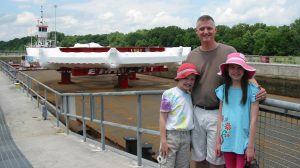
Breese Quinn and his son, Aidan, and daughter, Erin, watch the Muon g-2 ring pass through the G.V. ‘Sonny’ Montgomery Lock on the Tennessee-Tombigbee Waterway on its way to Fermilab on July 15, 2013. Quinn is among the collaborators on a landmark experiment using the massive electromagnet at Fermilab, which announced results recently that found muons behaving in a way not predicted by the Standard Model of particle physics. Photo courtesy Susanne Quinn
“(The recent news) is an extraordinary day, long-awaited not only by us but by the whole international physics community,” said Graziano Venanzoni, co-spokesperson of the Muon g-2 experiment and physicist at the Italian National Institute for Nuclear Physics. “A large amount of credit goes to our young researchers who, with their talent, ideas and enthusiasm, have allowed us to achieve this incredible result.”
The Muon g-2 experiment is Bhattacharya’s dissertation topic, and her work at UM and with Quinn has provided a unique opportunity for her to be at Fermilab where the experiment is taking place, helping her to grow immensely as a physicist.
“This is a very exciting time as we see the first result from the Fermilab Muon g-2 experiment,” said Bhattacharya, whose future research will further explore high-energy physics. “This was a great experience, a once-in-a-lifetime chance to be involved as a graduate student in such an important, groundbreaking effort.
“I grew up as a physicist in these three years, initially watching scientists and then actively participating in taking care of very difficult challenges while running the experiment and making sure that we are collecting the best-quality data for our measurement.
“Scientists are trying to explore the frontier of knowledge, and the g-2 experiment could be a stepping stone towards answering the fundamental questions we have.”
